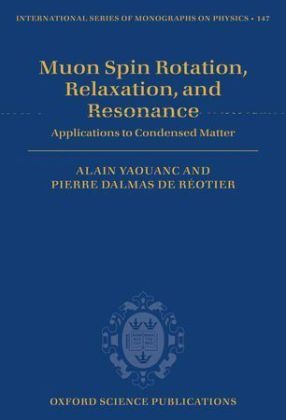Ulteriori informazioni
Zusatztext This book will be an important reference for scientists entering the field and at the same time an invaluable resource for experienced researchers. Informationen zum Autor Alain Yaouanc graduated from the University Joseph Fourier of Grenoble, France, in 1982. During his studies he spent about one year at CERN (Geneva, Switzerland). After his PhD, he spent one year as a postdoctoral scientist in the group of Bob Heffner at Los Alamos National Laboratory (USA). This group was involved in theinvestigation of condensed matter using positive muon spin rotation and relaxation techniques. Since 1983 he has been working as a physicist at the Commissariat à l'Energie Atomique (CEA) in Grenoble.; Pierre Dalmas de Réotier took his PhD at the Centre d''Etudes Nucléaires de Grenoble in 1990. In 1991he took up a Post-doctoral fellowship from the Alexander von Humboldt Foundation, studying spin dynamics in intermetallic systems at the Hahn-Meitner Institute in Berlin. Since 1992 he has been a Researcher at CEA Grenoble, and took his Habilitation diploma from University Joseph Fourier (Grenoble) in 2006. Klappentext Intended for graduate students and researchers who plan to use the muon spin rotation and relaxation techniques. A comprehensive discussion of the information extracted from measurements on magnetic and superconductor materials. The muonium centres as well as the muon and muonium diffusion in materials are discussed. Zusammenfassung Primarily intended for postgraduate students and researchers in the fields of condensed matter science, chemical physics and material science, who plan to use the muon spin rotation, relaxation amd resonance (µSR) techniques, this book combines for the first time a detailed discussion of the physical information contained in the measured polarisation functions with real-life examples taken from the literature. It is divided in three main parts. The first part presents some typical results of the application of µSR and explains the basic principles involved. The second part is the core of this book. It presents a comprehensive discussion of the measured polarisation functions. In the third part we analyse in four chapters selected examples taken from the following fields: diffusion properties of muon and muonium, magnetism, superconductivity, and muonium centres in materials. The book is completed by an epilogue and eight appendices. Inhaltsverzeichnis 1: A short survey of muon spin research; 2: Recording data and extracting the polarisation functions; 3: Basics of muon and muonium polarisation functions; 4: Miscellaneous techniques; 5: The magnetic field at the muon site; 6: Muon polarisation functions: field distribution approach; 7: Muon polarisation functions: quantum approach; 8: Muonium polarisation functions; 9: Muon and muonium diffusion; 10: Investigation of magnetic materials; 11: Investigation of superconductors; 12: Muonium centres in materials; 13: Epilogue: trends for the future; Appendices; A: Parameters and procedures relevant for experiments; B: Polarisation functions: a summary; C: Mathematical concepts and formulae; D: Laboratory and crystal reference frames; E: Translational symmetry and space Fourier transform; F: Susceptibility! correlation! spectral and Green functions; G: Nuclear data relevant to µSR; H: f and 3d electronic shell data ...

